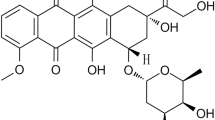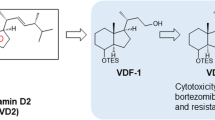Summary
Antitumor effects of erythromycin and the related mechanism were investigated in the present study. Neuroblastoma cells (SH-SY5Y) were exposed to erythromycin at different concentrations for different durations. Cell proliferation was measured by cell counting, and cell viability was examined by MTT assay. Cell cycle phase distribution and the cytosolic calcium level were detected by flow cytometry. Mitochondrial membrane potential was measured by the JC-1 probe staining and fluorescent microscopy. The expression of an oncogene (c-Myc) and a tumor suppressor [p21 (WAF1/Cip1)] proteins was analyzed by using Western blotting. Erythromycin could inhibit the proliferation of SH-SY5Y cells in a concentration- and time-dependent manner. The cell cycle was arrested at S phase. Mitochondrial membrane potential collapsed and the cytosolic calcium was overloaded in SH-SY5Y cells when treated with erythromycin. The expression of c-Myc protein was down-regulated, while that of p21 (WAF1/Cip1) protein was up-regulated. It was concluded that erythromycin could restrain the proliferation of SH-SY5Y cells. The antitumor mechanism of erythromycin might involve regulating the expression of c-Myc and p21 (WAF1/Cip1) proteins.
Similar content being viewed by others
References
Neu HC. The development of macrolides: clarithromycin in perspective. J Antimicrob Chemother, 1991, 27(Suppl A):1–9
Reich C. Erythromycin as an aid in the management of aleukemic myeloblastic leukemias. N Y State J Med, 1954,54(15):2208–2209
Hofsli E, Nissen-Meyer J. Reversal of drug resistance by erythromycin: erythromycin increases the accumulation of actinomycin D and doxorubicin in multidrug-resistant cells. Int J Cancer, 1989,44(1):149–154
Hamada K, Kita E, Sawaki M, et al. Antitumor effect of erythromycin in mice. Chemotherapy, 1995,41(1):59–69
Volberg WA, Koci BJ, Su W, et al. Blockade of human cardiac potassium channel human ether-a-go-go-related gene (HERG) by macrolide antibiotics. J Pharmacol Exp Ther, 2002,302(1):320–327
Park J R, Eggert A, Caron H. Neuroblastoma: biology, prognosis, and treatment. Hematol Oncol Clin North Am, 2010,24(1):65–86
Hahn WC, Weinberg RA. Modeling the molecular circuitry of cancer. Nat Rev Cancer, 2002,2(5):331–341
Gorlov IP, Byun J, Gorlova OY, et al. Candidate pathways and genes for prostate cancer: a meta-analysis of gene expression data. BMC Med Genomics, 2009,2:48
Gearhart J, Pashos EE, Prasad MK. Pluripotency redux—Advances in stem-cell research. N Engl J Med, 2007,357(15):1469–1472
Gustafson WC, Weiss WA. Myc proteins as therapeutic targets. Oncogene, 2010,29(9):1249–1259
Poluha W, Poluha DK, Chang B, et al. The cyclin-dependent kinase inhibitor p21 (WAF1) is required for survival of differentiating neuroblastoma cells. Mol Cell Biol, 1996,16(4):1335–1341
Mckenzie PP, Danks MK, Kriwacki RW, et al. P21Waf1/Cip1 dysfunction in neuroblastoma: a novel mechanism of attenuating G0–G1 cell cycle arrest. Cancer Res, 2003,63(13):3840–3844
Seoane J, Le HV, Massague J. Myc suppression of the p21(Cip1) Cdk inhibitor influences the outcome of the p53 response to DNA damage. Nature, 2002,419(6908): 729–734
June CH, Moore JS. Measurement of intracellular ions by flow cytometry. Curr Protoc Immunol, 2004, Chapter 5:Unit 5.5
Hu Y, Xia XY, Pan LJ, et al. Evaluation of sperm mitochondrial membrane potential in varicocele patients using JC-1 fluorescent staining. Zhonghua Nan Ke Xue (Chinese) 2009,15(9):792–795.
Lovmar M, Nilsson K, Vimberg V, et al. The molecular mechanism of peptide-mediated erythromycin resistance. J Biol Chem, 2006,281(10):6742–6750
Chen SZ, Jiang M, Zhen YS. HERG K+ channel expression-related chemosensitivity in cancer cells and its modulation by erythromycin. Cancer Chemother Pharmacol, 2005,56(2):212–220
Baumann S, Fas SC, Giaisi M, et al. Wogonin preferentially kills malignant lymphocytes and suppresses T-cell tumor growth by inducing PLCgamma1- and Ca2+-dependent apoptosis. Blood, 2008,111(4): 2354–2363
Dick JE. Stem cell concepts renew cancer research. Blood, 2008,112(13):4793–4807
Dang CV. c-Myc target genes involved in cell growth, apoptosis, and metabolism. Mol Cell Biol, 1999,19(1): 1–11
Pelengaris S, Khan M, Evan G. c-MYC: more than just a matter of life and death. Nat Rev Cancer, 2002, 2(10):764–776
Li F, Wang Y, Zeller KI, et al. Myc stimulates nuclearly encoded mitochondrial genes and mitochondrial biogenesis. Mol Cell Biol, 2005,25(14):6225–6234
Gao P, Tchernyshyov I, Chang TC, et al. c-Myc suppression of miR-23a/b enhances mitochondrial glutaminase expression and glutamine metabolism. Nature, 2009, 458(7239):762–765
Dang CV, Le A, Gao P. MYC-induced cancer cell energy metabolism and therapeutic opportunities. Clin Cancer Res, 2009,15(21):6479–6483
Dominguez-Sola D, Ying CY, Grandori C, et al. Non-transcriptional control of DNA replication by c-Myc. Nature, 2007,448(7152):445–451
Dai MS, Jin Y, Gallegos JR, et al. Balance of Yin and Yang: ubiquitylation-mediated regulation of p53 and c-Myc. Neoplasia, 2006,8(8):630–644
Author information
Authors and Affiliations
Corresponding author
Rights and permissions
About this article
Cite this article
Yongsheng, J., Xiaoyun, M., Xiaoli, W. et al. Antitumor activity of erythromycin on human neuroblastoma cell line (SH-SY5Y). J. Huazhong Univ. Sci. Technol. [Med. Sci.] 31, 33–38 (2011). https://doi.org/10.1007/s11596-011-0146-4
Received:
Published:
Issue Date:
DOI: https://doi.org/10.1007/s11596-011-0146-4




